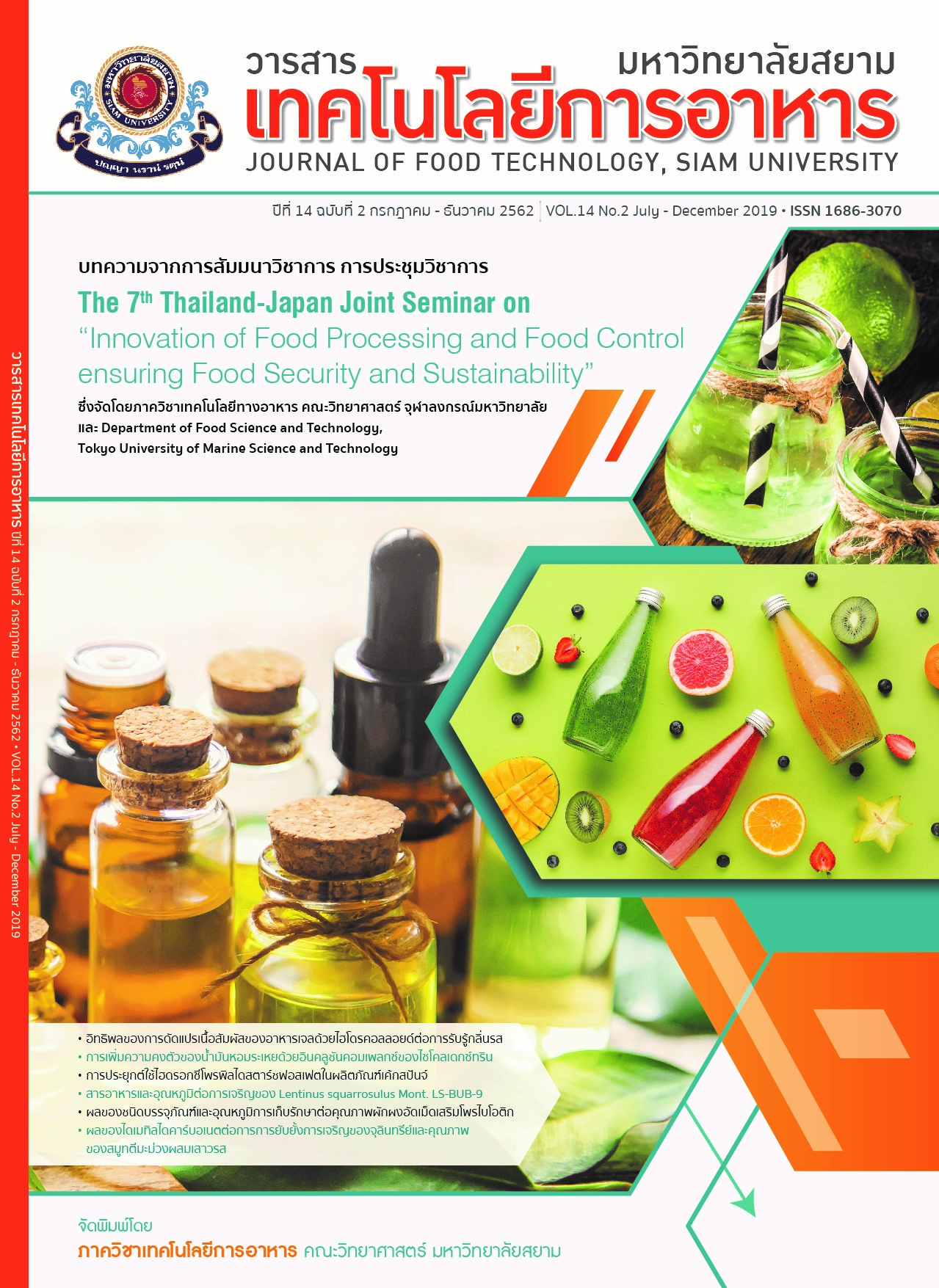Effect of Nutrients and Temperature on Growth of Lentinus squarrosulus Mont. LS-BUB-9
Main Article Content
Abstract
The mycelia culture of Lentinus squarrosulus Mont. LS-BUB-9 was isolated from a mushroom fruiting body in Ubon Ratchathani Province, Thailand. The culture was grown on a liquid basal medium to reach maximum growth, reaching the stationary phase in 25 days. Concentrations of C-source, N-source in the medium and incubation temperature were the factors investigated. Surface response methodology was used to determine a prediction model for investigating changes of the growth of the culture. The incubation temperature had positive interactions with increasing both N-source and C-source. When increasing incubation temperature from 25 to 35oC, the biomass production increased. The highest biomass production was obtained by incubating at 35oC for 25 days with the addition of 3% (w/v) sucrose and 0.3% (w/v) ammonium sulfate in the basal medium.
Article Details
Copyrights of all articles in the Journal of Food Technology available in print or online are owned by Siam University and protected by law.
References
[2] Jin, B., Yan, X.Q., Yu, Q. and van Leeuwen, H.J. (2002). A comprehensive pilot plant system for fungal biomass and protein production and waste water reclamation. Advances in Environmental Research. 6(2): 179-189.
[3] Estevez, E., Velga, M.C. and Kennes, C. (2005). Biodegradtion of toluene by the new fungal isolates Paecilomyces varioli and Exophialaol digosperma. Journal of Industrial Microbiology and Biotechnology. 32(1): 33-37.
[4] Royse, D.J., Baars, J. and Tan, Q. (2017). Current overview of mushroom production in the world. In Edible and Medicinal Mushrooms: Technology and Applications ed by Diego, C.Z. and Pardo-Giménez. John Wiley & Sons Ltd.
[5] Christias, C., Couvaraki, C., Georgopoulos, S.G., Macris, B. and Vomvoyanni, V. (1975) Protein content and amino acid composition of certain fungi evaluated for microbial protein production. Applied Microbiology. 29(2):250-254.
[6] Fasidiand, I.O. and Kadiri, M. (1991). Changes in nutrient contents of Termitomyces robustus (Geeli) Heim and Lentinus subnudus Berk during sporophore development. Acta Botanica Hungarica. 36: 167-172.
[7] Atikpo, M., Onokpise, O., Abazinge, M., Louime, C., Dzomeku, M., Boateng, L. and Awmbilla, B. (2008). Sustainable mushroom production in Africa: A case study in Ghana. African Journal of Biotechnology. 7(3): 249-253.
[8] Mind Omar, N.A., Abdulah, N., Kuppusamy, U.R., Abdulla, M.A. and Sabaratnam, V. (2011). Nutritional composition, antioxidant activities and antiulcer potential of Lentinus squarrosulus (Mont.) mycelia extract. Evidence-based complementary and alternative medicine. Vol 2011 Article ID 53356, 8 pages [Online] Available from https://www.hindawi.com/ journals/ecam/2011/539356/)
[9] Zhou, S., Tang, Q.J., Zhang, Z., Li., C.H., Yang, Y. and Zhang, J.S. 2015. Nutritional composition of three domesticated culinary-medicinal mushrooms: Oudemanseilla sudmusida, Lentinus squarrosulus, and Tremella aurantialba. International Journal of Medicinal Mushrooms. 17: 43-49.
[10] Pi, N., Au, K., JB, A. and VJ, U. 2006. Nutritional studies with Lentinus squarrosulus (Mont.) Singer and Psathyrella atroumbonata Pegler: I. Animal assay. African Journal of Biotechnology 5(5): 457-460.
[11] Idwan Sudriman, L., Lefebvre, G., Kiffer, E. and Botton, B. (1994). Purification of antibiotics produced by Lentinus squarrosulus and preliminary characterization of a compound active against Rigidoporus lignosus. Current Microbiology. 29: 1-6.
[12] Ghate, S and Sridhar, K. (2017). Bioactive potential of Lentinus squarrosulus and Termitomyces clypeatus from the Southwestern region of India. Indian Journal of Natural Products and Resources. 8(2): 120-131.
[13] Joshi, SR., Das, A.R., Borthakur, M., Saha, A.K., Joshi, S.R. and Das, P. (2015). Growth of mycelial biomass and fruit body cultivation of Lentinus squarrosulus collected from home garden of Tripura in Northeast India. Journal of Applied Biology & Biotechnology. 3(4): 17-19.
[14] Anike, F.N., Isikhuemhen, O.S., Blum, D. and Neda, H. (2015). Nutrient requirements and fermentation conditions for mycelia and crude exo-polysaccharides production by Lentinus squarrosulus. Advances in Bioscience and Biotechnology. 6: 526-536.
[15] Pokhrel, C.P. and Ohga, S. (2007). Submerged culture conditions for mycelia yield and polysaccharides production by Lyophyllum decastes. Food Chemistry. 105: 641-646.
[16] Yang, F.C., Huang, H.C. and Yang, M.J. (2003). The influence of environmental conditions on mycelia growth of Antrodia cinnamomea in submerged cultures. Enzyme Microbial Technology. 33: 395-402.
[17] Gbolagade, J., Sobowale, A. and Adejoye, D. (2006). Optimization of sub-merged culture condition for biomass production in Pleurotus florida (mont.) Singer, a Nigerian edible fungus. African Journal of Biotechnology 5(6): 1464-1469.
[18] Hassegawa, R.H., Kasuya M.C.M. and Vanetti, M.C.D. (2005). Growth and antibacterial activity of Lentinula edodes in liquid media supplemented with agricultural wastes. Electronic Journal of Biotechnology. 8(2): available at https://www.ejbiotechnology.info/ index.php/ejbiotechnology/article/view/v8n2-3/464
[19] Chang, S.T. and Miles, P.G. (1989). In Edible mushrooms and their cultivation. CRC Press Inc., Florida, 345 p
[20] Wu, J.Z., Cheungo, P.C.K., Wong, K. and Hang, N. (2003). Studies on submerged fermentation of Pleurotus tuberregium (fr.) Singer. Part I: physical and chemical factors affecting the rate of mycelia growth and bioconversion. Food Chemistry. 81: 389-393.
[21] Petcharatana, V. (1995). Culturing wild mushroom: Hed Korn Kao (Lentinus squarrosulus Mont.). Songklanakalin campus. Songklanakalin University.
[22] Roy Das, A., Borthakur, M., Saha, A.K., Joshi, S.R. and Das, P. (2015). Growth of mycelial biomass and fruit body cultivation of Lentinus squarrosulus collected from home garden of Tripura in Northest India. Journal of Applied Biology and Biotechnology. 3(4): 17-19.


